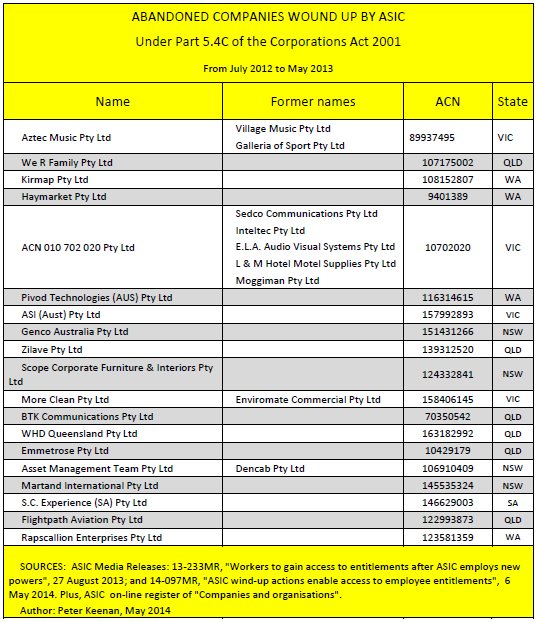New laws have been drafted to give the Australian Securities and Investments Commission (ASIC) power to wind up companies. But what mode of winding up will these liquidations be? Creditors’ voluntary liquidation, or failed members’ voluntary liquidation? And will there be any requirement that directors prepare a statement of assets and liabilities?
The focus in this post is on a proposed new section of the Corporations Act 2001, namely section 489EB — “Deemed resolution that company be wound up voluntarily”.
The section seems, at the beginning, to be proposing that the winding up proceed as a creditors’ voluntary winding up. Subsections 489EB(a) and (b) state:
“(a) the company is taken to have passed a special resolution under section 491 that the company be wound up voluntarily; and
(b) the company is taken to have passed the special resolution:
(i) at the time when ASIC made the order under section 489EA; and
(ii) without a declaration having been made and lodged under section 494; ”
In other words, it is deemed to be a creditors’ voluntary liquidation because the deemed resolution to wind up the company is deemed to have not been accompanied by a declaration of solvency under section 494.
But then in subsection 489EB(c) reference is made to section 496: a section that only applies where a declaration of solvency has been made under section 494.
Section 496 – Duty of liquidator where company turns out to be insolvent – applies in a members’ voluntary liquidation. But how could section 496 have any application?
To me the reference to section 496 seems to be in direct conflict with (proposed) subsections 489EB(a) and (b).
If section 496 does somehow have some application as (proposed) section 489EB(c) seems to suggest, then it would appear that the winding up by the ASIC is to be a members’ voluntary winding up where a company turns out to be insolvent.
If section 496 (for members’ voluntary liquidations) does apply, then section 496(2) – notice to creditors, section 496(4) – liquidator to lay before meeting a statement of assets and liabilities, and section 496(5) – replacement of liquidator, and the other subsections in 496, would be brought into play, wouldn’t they? Is this intentional or are these oversights or unintended consequences?
If section 496 is to have some application in a winding up by the ASIC, does that mean that the liquidator may choose a path other than the winding up of the company? I ask this because section 496(1) gives the liquidator the option to apply under section 459P for the company to be wound up in insolvency, or appoint an administrator of the company under section 436B, or convene a meeting of the company’s creditors? Is this intentional or are these oversights or unintended consequences?
If the winding up is a creditors’ voluntary winding up, then it appears that — unlike in an ordinary creditor’ voluntary winding up — there will be no requirement of directors to submit a Report as to Affairs (RATA). This is so because the section that does require a RATA from the directors — section 497(5) — seems, along with all other parts of section 497, to have been made inapplicable by the following words of (proposed) subsection 489EB(d), “section 497 is taken to have been complied with in relation to the winding up”.
The same would be true of section 497(2)(b)(i), which requires the liquidator to send creditors a summary of affairs (Form 509). It too would be “taken to have been complied with in relation to the winding up”.
Which suggests that when a company is wound up by the ASIC there will be no requirement on the part of directors to prepare and submit a statement about the company’s business, property, affairs and financial circumstances.
This seems strange given that in the other two types of insolvent winding up – court-ordered winding up and creditors’ voluntary winding up– such a statement is required. Is this an oversight or an unintended consequence?
Also, the removal of a duty to do a RATA would be extraordinary when liquidators say – as made clear in my recent IPA sponsored survey of official liquidators – that a RATA from directors is a very valuable tool for the efficient conduct of a winding up.
This is all that the official Explanatory Memorandum says about proposed section 489EB:
“If ASIC exercises its powers to wind up a company under the new law, the company is deemed to have passed a special resolution under existing section 491 of the Corporations Act that the company be wound up voluntarily. The resolution is deemed to have been made on the day that ASIC uses its administrative power to order the winding up and does not require a declaration of solvency to have been made under existing section 494 of the Corporations Act. A meeting of creditors under existing subsection 497(1) of the Corporations Act is not required where the winding up has been ordered by ASIC. “
The peculiar phrase “The resolution … does not require a declaration of solvency to have been made under existing section 494” suggest to me a lack of understanding of the law.
And the reference to subsection 497(1) is odd given that the proposed law refers to section 497 as a whole, not just subsection 497(1). Has there been a mistake in drafting subsection 489EB(d)? Should it refer more narrowly to subsection 497(1) rather than to the whole section?
